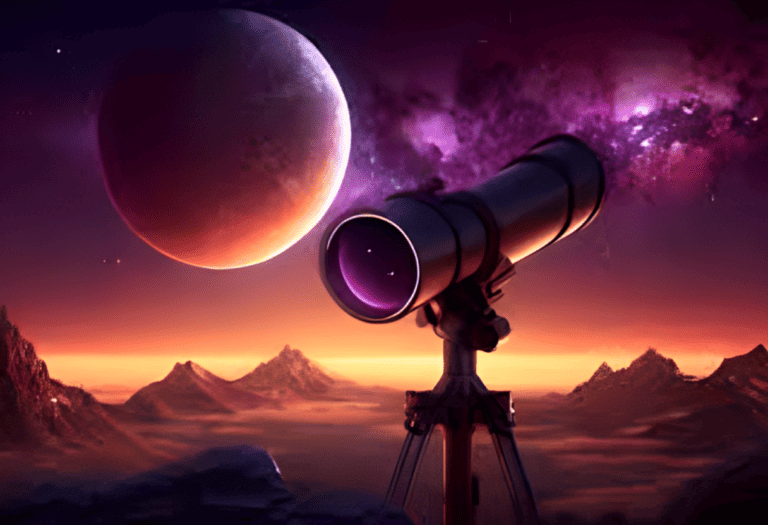Are you mesmerized by the moon’s allure, eager for the best telescope for the moon and see its mysterious craters and mountains up close?
Telescopes provide an extraordinary means to delve into lunar landscapes, bringing the moon’s captivating surface features into clear view. The moon, with its dynamic terrain and phases, offers an ever-changing spectacle in the night sky, making it an ideal target for both novice and seasoned astronomers.
Well, we’ll be going over:
- What makes a telescope’s aperture size so crucial for detailed lunar observation?
- How does the type of mount impact your experience while observing the moon’s surface?
- What role do eyepieces play in enhancing the quality of lunar viewing through a telescope?
Unlock the secrets of selecting the perfect telescope for moon gazing, ensuring your celestial explorations are both thrilling and enriching.
Let’s dive in.
Top Telescopes for Lunar Observation
- ABOTEC 90mm Refractor Telescope – Top Pick
- HSL Moon Gazer
- Celticbird AZ Scope for Starters
- HOROX Moon Explorer
- AstroMaster 70AZ
I’ve spent numerous hours researching and comparing various models to find the best telescopes for viewing the moon’s surface in remarkable detail. The telescopes I’ve selected cater to a range of expertise levels and budgets, ensuring there’s an option for everyone who shares a fascination with our lunar neighbor. Whether you’re a beginner stargazer or a seasoned astronomer, these picks will enhance your moon-watching experiences.
ABOTEC 90mm Refractor Telescope

I recommend this telescope for anyone who wants to gaze at the moon with clarity and ease, thanks to its user-friendly features and powerful optics.
Pros
Cons
Having recently spent a night with the ABOTEC 90mm Refractor Telescope aimed at the lunar surface, I admired the moon’s craters with incredible detail that left me awestruck. The brilliant clarity of the refractor met my expectations, enhancing my viewing experience substantially.
Setting up this telescope was a breeze. I followed the manual closely and within minutes, I was ready to go. The fact that it’s designed for portability translates to more opportunities for stargazing adventures in various locations.
The magnification range provided is noteworthy; from broad, stunning lunar landscapes to more focused views of the moon’s surface, I zoomed in on features I’d only seen in textbooks before. However, getting the focus just right took a few attempts, but the crisp images I eventually captured were well worth the effort.
The sturdy tripod held up well as I panned across the night sky, though I did take extra care to find even ground. While the process of aligning everything can be intimidating at first, with a little patience, I achieved a perfectly framed lunar vista.
Experiencing this telescope’s capabilities firsthand, I can confidently say that it’s a great option for both beginners and more seasoned skywatchers looking to drink in the beauty of our celestial neighbor.
HSL Moon Gazer

After spending a few evenings with the HSL Moon Gazer, I believe it’s a solid choice for families looking to explore lunar landscapes.
Pros
Cons
My first glimpse through the HSL Moon Gazer took my breath away. The surface of the moon was rendered in such crisp and vibrant detail that it felt like I could reach out and touch the craters. The high-definition optics did not disappoint; every viewing was a treat for the eyes.
The viewfinder was another highlight. Aligning the crosshairs with my target made finding celestial objects much less frustrating than with other telescopes. Whether it’s a full moon or a crescent, getting the telescope pointed in the right direction was surprisingly straightforward.
Portability is a big plus for this model. Packing the telescope and tripod into the custom backpack, I found it easy to take on a trip outside the city limits where the skies are clearer. Observing the night sky away from urban light pollution was a game-changer and the HSL Moon Gazer didn’t add any burden to the adventure.
On the downside, the tripod’s stability could be improved. A few times, I experienced slight tremors while tracking objects across the sky, which can make high-magnification viewing a delicate task. Patience is key here.
Setting up for the first time, I had to play around with the adjustments to find the sweet spot. The focus mechanism in particular requires a tender approach. Move it too briskly and you could find yourself starting the focusing process all over again.
All in all, my time with the HSL Moon Gazer has been quite rewarding. It simplifies the complex task of celestial viewing and brings the wonders of the moon a little closer to earth. For those looking to share the beauty of the night sky with young astronomers, this telescope could be a gateway to the stars.
Celticbird AZ Scope for Starters

I found the Celticbird Telescope ideal for moon viewing, offering a balance of quality, portability, and user-friendliness that’s hard to beat.
Pros
Cons
Upon setting up the Celticbird Telescope, I immediately noticed the convenience of its portability. The backpack was a handy touch, fitting all the essentials needed for moon gazing on the go. As I extended the tripod and secured the telescope, its stability impressed me; there was no wobbling, and it easily carried the optical tube’s weight.
Gazing up at the Moon, the visuals were a delight. The telescope’s 80mm aperture and quality eyepieces allowed me to see craters and mares with excellent clarity. Switching between magnifications was a breeze, and though focusing required some finesse, the final image was always rewarding.
The addition of a phone adapter was a welcome feature. It enabled me to align my smartphone with the telescope’s lens quickly, allowing me to capture and share the lunar beauty with friends. While the telescope caters to novices and intermediate stargazers, I found myself wishing for more advanced features – a minor quibble, given the telescope’s value.
In conclusion, the Celticbird 80x600mm Telescope struck me as a great choice for anyone looking to explore the Moon’s mysteries from their backyard. Its ease of use, clear optics, and the bonus of photographic capability provided me with delightful evenings of lunar observation.
HOROX Moon Explorer

The HOROX Moon Explorer refractor telescope has become a trusted companion for my lunar observations, combining ease of use with quality visuals.
Pros
Cons
Observing the moon’s rugged terrain through the HOROX Moon Explorer’s fully multi-coated 70mm lens has been a remarkable experience. The clarity of the craters and the stark contrast against the blackness of space takes my breath away every time. This telescope makes lunar viewing accessible and enjoyable, serving as an excellent tool for beginners and intermediate users alike.
Mounting the telescope on the adjustable tripod is remarkable for its simplicity and stability. Accommodating both adults and kids, it allows for a comfortable viewing angle, which is essential during prolonged stargazing sessions. The guided installation video was particularly helpful in setting everything up without a hitch.
Capturing the beauty of the moon with my smartphone is a cinch with the included adapter. Sharing these moments with friends and family has never been easier, and it often feels like sharing a live window into space. It’s a feature that consistently brings a new dimension to my astronomical pursuits.
AstroMaster 70AZ

I just observed the moon’s majestic craters with the AstroMaster 70AZ, and it’s a solid choice for both beginners and seasoned lunar enthusiasts.
Pros
Cons
I’m always thrilled when I can unbox a new telescope and get it ready without a hitch. The AstroMaster 70AZ took mere minutes to set up, and I was peering at the lunar surface in no time. The moon was brilliantly detailed, and even terrestrial viewing was a treat with the upright image optics.
Navigating the night sky felt smooth once I got the hang of the panhandle Alt-Az controls. At first, they were a bit stiff, but after some trial and error, pointing the telescope became a more intuitive experience. The lightweight design meant I could easily move it to find the perfect stargazing spot.
The only true snag I hit was with the StarPointer finderscope. Aligning it to the telescope’s optics was a bit of a challenge, and it’s not as user-friendly as I’d like. Stability is key for stargazing, and while the tripod is decent, there’s a noticeable wobble when making fine adjustments, but it’s manageable after some practice.
Buying Guide
Understanding Telescope Types
I’ll start by identifying the main types of telescopes suitable for lunar observations:
- Refractors use lenses to form the image.
- Reflectors use mirrors.
- Catadioptrics combine lenses and mirrors for a compact design.
Key Features to Consider
When selecting a telescope, I consider these features crucial:
- Aperture: The aperture size determines the light-gathering ability; larger apertures offer clearer, brighter lunar images.
- Magnification: This is the telescope’s power to enlarge the image. It’s important to note that a stable, clear image often matters more than high magnification.
- Focal Length: Longer focal lengths provide higher magnification and a narrower field of view, which is great for moon observation.
- Mount: A sturdy and smooth mount is essential for tracking the moon’s movement without vibration.
Comparing Specifications
| Feature | Importance for Lunar Observation | Note |
|---|---|---|
| Aperture | High | The larger, the brighter the image. |
| Magnification | Moderate | Opt for a balance with image quality. |
| Focal Length | High | Longer for closer lunar details. |
| Mount | High | Stability is key for clear viewing. |
Accessories
Choosing the right accessories can enhance lunar observation:
- Eyepieces: A collection with different focal lengths offers diverse magnification options.
- Filters: Moon filters reduce brightness and glare, improving contrast and detail.
- Barlow Lens: This doubles or triples the effective magnification of your eyepieces.
Seeking the best telescope to observe the moon requires balancing between aperture, magnification, focal length, and mount stability. I also consider the adaptability with accessories like eyepieces and filters to enhance the viewing experience.
Frequently Asked Questions
In my experience with telescopes, certain features and considerations become pivotal when observing the moon. I’ll address frequent queries related to lunar observation with telescopes, focusing on specifics for beginners, budget range, detailed viewing, urban use, lunar photography, and necessary magnification.
What features should I look for in a telescope if I’m a beginner interested in lunar observations?
When starting out, opt for a telescope with a sturdy mount, clear optics, and around 25-50x magnification. A reflector telescope or a simple refractor can be excellent choices due to their ease of use and maintenance.
How do different budget telescopes compare in terms of viewing the moon?
For budget telescopes, a simple Dobsonian telescope offers a large aperture and a simple mount, which ensures a bright and clear view of the moon. Smaller refractors and compound telescopes are also capable, although they might offer less detail than the Dobsonians at the same price point.
Which telescopes are recommended for detailed observations of the moon’s surface?
For detailed views of the lunar surface, including craters and mountain ranges, telescopes with larger apertures and higher resolution, like the Schmidt-Cassegrain and Maksutov-Cassegrain models, are my recommendation. An aperture size of at least 8 inches will allow for more detailed observations.
Can you suggest telescopes that are effective for moon viewing from light-polluted urban areas?
From light-polluted areas, a telescope with a larger aperture is beneficial to gather more light. Maksutov-Cassegrain telescopes, known for their compact and closed-tube design, tend to perform better in urban settings by cutting down on internal light reflections.
What type of telescope offers the best value for someone primarily interested in lunar photography?
For lunar photography, a telescope with a sturdy mount and the ability to attach a camera, such as a computerized equatorial mount, is ideal. The Schmidt-Cassegrain type offers versatility and high-quality optics, which is key for capturing detailed photos of the moon.
What should be the minimum magnification of a telescope to observe the moon in detail?
A minimum magnification of 50x is ideal for detailed lunar observations. However, the clarity of the details also heavily depends on the telescope’s aperture, where a larger aperture will provide a clearer image. It’s vital to balance magnification with stability and clarity to avoid a shaky or blurry view.







